
In today’s digital world, your potential customers are savvy. By simply browsing online, they make far more informed buying decisions than ever before.
This makes it tough for your business-to-business (B2B) brand to stand out from the crowd.
However, with the right inbound sales tactics, you can attract potential customers, meet their expectations, and solve their problems with your products and services.
To get this right, you need a solid B2B inbound sales strategy backed by in-depth research, high-quality content, and personalization to create a seamlessly integrated approach.
In this article, we’ll look at everything you need to include in your inbound sales strategy to stand out from the competition and help your business thrive.
What Is Inbound Sales?
Inbound sales is a marketing tactic that prioritizes the goals and needs of the customers and slowly guides them through the decision-making process before closing the sale.
Unlike outbound marketing which initiates direct contact with clients, inbound strategies are often more personalized and focus on creating content to attract customers organically.

This means that the inbound sales approach also relies heavily on buyer journeys.
A good inbound salesperson or marketer looks to create personalized messages for each prospect—depending on where they are in their purchase process—to improve their journey.
Ideally, you attract inbound leads to your brand thanks to your high-quality content.
Inbound lead generation is a more subtle strategy than outbound sales. It’s a long-term approach that prioritizes value over numbers.
It can also be more time-efficient, as you don’t waste hours on leads who are potentially uninterested in your offer, which is sometimes the case with outbound leads.
How Is a B2B Sales Strategy Different from B2C?
A B2B sales strategy differs considerably from a business-to-consumer (B2C) strategy. Here are some significant ways a B2B strategy differs from a B2C approach.
Smaller lead pool
When you deal with B2C sales, you can safely assume that your target group includes millions of prospects. The idea is that you’ll engage with as many people as possible through approaches like cold calls in the hope that you’ll attract more customers.
In B2B sales, your lead pool is much smaller as you’re targeting specific potential clients.
With B2B sales, you need to execute a more tailored strategy to get your target audience’s attention and convert them into paying customers.
Required knowledge
In B2B sales, you often deal with people who know exactly what they need.
The decision-makers you’re targeting understand their business needs and can quickly determine whether your product or service will help them.
For this reason, your sales team needs to be experts on your brand offering.
This allows them to have impactful conversations that can drive sales, even when they’re working with industry experts
The same goes for your content. It needs to cover topics in-depth and provide value to people already familiar with what you’re covering.
A slower sales process
B2C salespeople usually sell to customers who can make quick decisions, such as individuals and families who need consumer products.
A consumer-driven outbound approach focuses on making these sales by contacting as many people as possible. This makes sales happen faster.
However, in the B2B industry, your contacts are decision-makers who must convince their entire company that your product meets a specific need.
This means that the sales process often takes longer as you reach out to fewer people and build a relationship with each of them.
Once you’ve interacted with potential clients, they are divided into two lead scoring groups; a marketing-qualified lead (MQL) and a sales-qualified lead (SQL).
An MQL is someone who has engaged with your brand but is still undecided about whether they want to close the deal.
They often need to be nurtured through building stronger relationships before you can make the sale, which can take a while.
Sales-qualified leads, on the other hand, are interested in purchasing your products and ready to speak with your sales team.
Deeper relationships
Consumer brands with a mass market rarely manage to create a deeper connection with their audience.
On the other hand, B2B relationships are built on trust, results, and mutual success. As such, their nature is more extensive than B2C relationships.
9 Strategies To Get Your B2B Inbound Sales Right
Now that you know more about inbound marketing in the B2B space, let’s unpack how to get this marketing strategy right.
1. Define the buyer’s journey
The first part of any good inbound marketing strategy starts with identifying the journey your prospects will go on before they decide to sign up for your product or service.
You need to define, understand, and craft your buyer journeys before you launch your B2B inbound sales campaign.

As you can see in the image above, the customer journey has three stages: awareness, consideration, and decision.
Your inbound lead generation strategy should guide the buyer through each stage of the journey with content and personalization that nudges them to take the next step.
Here is how it works:
➡️ Awareness stage
In this stage, a potential customer is aware of the problems they want to solve or a goal they want to achieve.
They start realizing that they want to address that issue or goal and are in the process of considering whether your brand can help them achieve that.
At this point, interested prospects start to become leads.
➡️ Consideration stage
Buyers now have clearly defined goals and want to address them. They start to evaluate various products and services that could help them.
This is where you need to craft a unique value proposition that clearly addresses your prospect’s pain points and how your brand can help them reach their goals.
In the consideration phase, your prospects go from being leads to qualified leads. At this stage, you need to meet them where they are by starting to build a relationship with them and helping them explore your product or service.
➡️ Decision stage
Here, the users have landed on a specific solution to their pain points. They start comparing different vendors and their offers to reach a decision.
In this stage, you need to identify which products your prospects are considering and focus on what makes your offering different from your competitors.
In the decision phase, qualified leads turn into opportunities and, ideally, paying clients.

2. Segment your audience
Once you’ve defined the buyer’s journey, it’s time to start thinking about the different types of prospects you want to attract with inbound marketing, also known as your target audience.
You can segment your audience by using several approaches. One popular tactic is to create audience personas. These then become your ideal customer profiles (ICPs).
For example, let’s say you sell a social media automation tool. You might want to have an audience persona who is a decision-maker in a digital marketing agency.
Ask yourself how old this person is, what their interests are, and how they’d prefer to be approached by brands.
Answers to these questions will allow you to dig deep into what kind of marketing the person will likely respond to.
You can also use analytics tools to segment your audiences. By studying your Google Analytics data, for example, you’ll be able to see which demographic groups visit your website most frequently. And, with heat mapping tools like Hotjar, you’ll see what kind of content they’re interested in. To take it a step further, you can use IP tracking tools or CRM integrations to identify website visitors and learn which companies or industries are engaging with your content.
Bring these two together, and you’ll have a more accurate insight into your visitors and their behavior.
Here’s what the demographic view looks like on Google Analytics. This should help you segment your audience:

Once you know who is visiting your website and what’s driving them to do so, you’ll be ready to deliver them the content they want to see.
3. Consistently create good content
One of the pillars of inbound sales is content. The content on your website should be aimed at keeping your buyer personas engaged and convincing them to do business with you.
The content you use goes beyond your website. Think about newsletters and social media content, too.
To create good content, you have to think long-term.
The goal isn’t to sell something as fast as possible but rather to position yourself as an expert in your industry so that users in search of answers come to you.
If your team doesn’t have the time or expertise to manage this internally, partnering with an SEO content agency can help you consistently produce high-quality, optimized content that drives traffic and conversions.

Search engine optimization (SEO) is also an important part of creating content, as it helps make your website visible in search results.
The content creation process takes time and effort to get right, but here are some tips to get you started:
🔎 Do your keyword research
The basis of SEO is keyword research. Consult Google’s Keyword Planner—or invest in a different keyword research tool like Ahrefs—to see which keywords to target when you create content.
Here’s what the Keyword Planner tool looks like when you search for keywords you can use in your content:
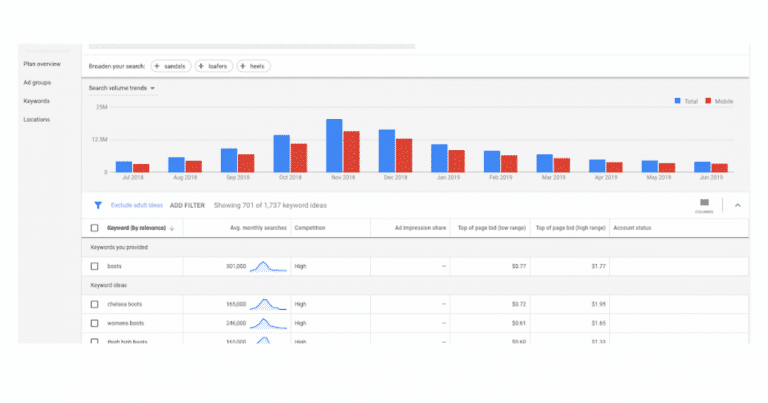
These tools can also help you determine which type of content your audience enjoys most—such as long-form articles, videos, or podcasts—to tailor your sales strategy further.
✍️ Write quality content
Once you’ve selected the keywords you want to create content around, it’s time to start producing your content.
But as a long-term strategy, simply creating content that uses keywords isn’t enough.
Content that is hyper-focused on keywords and ignores other requirements tends to be lower quality and doesn’t always attract audiences.
High-quality content is:
- Insightful: Beyond simply using keywords, your content needs to help the reader in some way. Search engines prefer content that is genuinely helpful and relevant to audiences.
- Original: Many people will be writing about the topics you’ll be covering. To stand out, you need to convey some original insights. You may want to consider including expert opinions and quotes from people within your company to provide the reader with original information.
- Skimmable: In today’s online world, readers don’t have the time or attention span to wade their way through large chunks of information. Ensure your content is easy to skim but still gets the overall message across.
- Concise: No one wants to read wordy and complex content unless it’s within a specific context where it’s expected, like in a whitepaper. Keep your writing succinct, and cautiously avoid including too much heavy text.
- Actionable: Your content should include a strong call to action (CTA) that tells the user exactly where to go or what action you want them to take next. Simply providing audiences with content alone isn’t going to enhance your inbound marketing efforts—you need to direct them to the next step.

🔗 Start link building
Once you’ve established a content strategy, you may want to consider building backlinks to strengthen your SEO and get more eyes on your content.
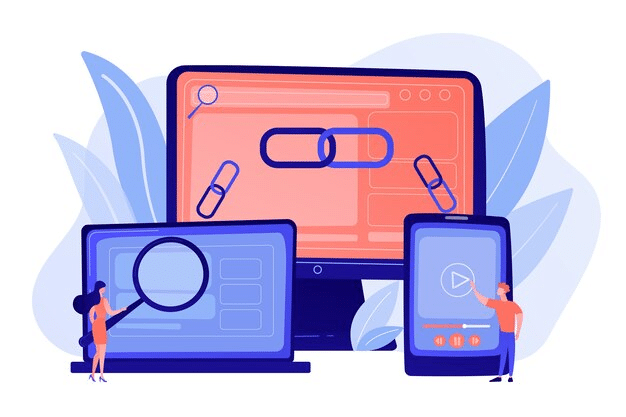
Simply put, backlinks are links found on other websites that lead to your content. If you earn enough high-quality backlinks, search engines may consider your page relevant and authoritative enough to display early in search results.
Some basic link-building strategies you may want to consider include:
- Guest posting: This is when you write content for websites that accept guest blog posts. These guest posting opportunities allow you to include a link in the article that points back to your website, helping you gain visibility and build authority.
- Digital press releases: Writing and publishing press releases that contain a link to your website is a great way to build backlinks, especially if journalists or bloggers pick up your release.
- Creating data-driven content: If the content on your own website is rich in original data, other sites will be drawn to link to your content. For example, if you compile a report that provides statistics on a particular subject that you have researched yourself, you may start attracting backlinks.
4. Personalize your website
Another strategy that can help you increase inbound sales and generate leads is personalizing your website.
Think about it, which website has a higher chance of converting a lead into a customer: the one with the same generic content for every visitor, or the one that calls each visitor by their name, uses personalized CTAs, and even displays a tailored offer to each lead?
Around 80% of companies report better results since they’ve invested in personalization. Consumers are also interested in getting more personalized content: 79% of them are willing to give brands their personal data to get tailored recommendations.
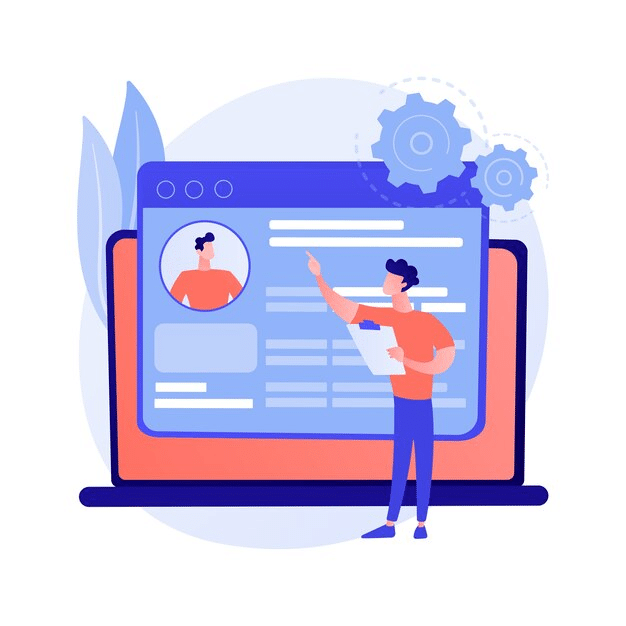
At Hyperise, we believe in hyper-personalization. You can (and should) personalize more than just your offer.
With the Hyperise editor, images, GIFs, videos, CTAs, and pieces of text can all be personalized for each visitor. This can truly impress prospects and turn leads into customers.
Take a look at how our home page would look if visited by Tim Cook from Apple, for example:

We use a deeply personal approach, using their company logo and name throughout the page.
If you want to do the same thing, register for a free trial of Hyperise.
5. Adopt a multichannel strategy
For inbound sales to work best, you need to be present wherever your prospects might be looking for you.
This means that communication options should extend across your social media accounts, email, and website for your potential customers to contact you and ask questions.
Since you’ll be focusing on B2B sales techniques, you should pay special attention to LinkedIn, as this is where decision-makers in companies spend a lot of time.
Your B2B prospects may even manually search for your sales representatives on LinkedIn and reach out to them with questions.
6. Invest in paid search
While SEO is a long-term tactic to get a good position in Google search results, search ads can get you inbound leads faster.
The idea behind search ads is similar to SEO: you identify relevant keywords connected to your offer that people would search for online. You then pay to land the top result spot in the sponsored section of Google search results.
Here’s what search ads using the Google Ads platform look like:
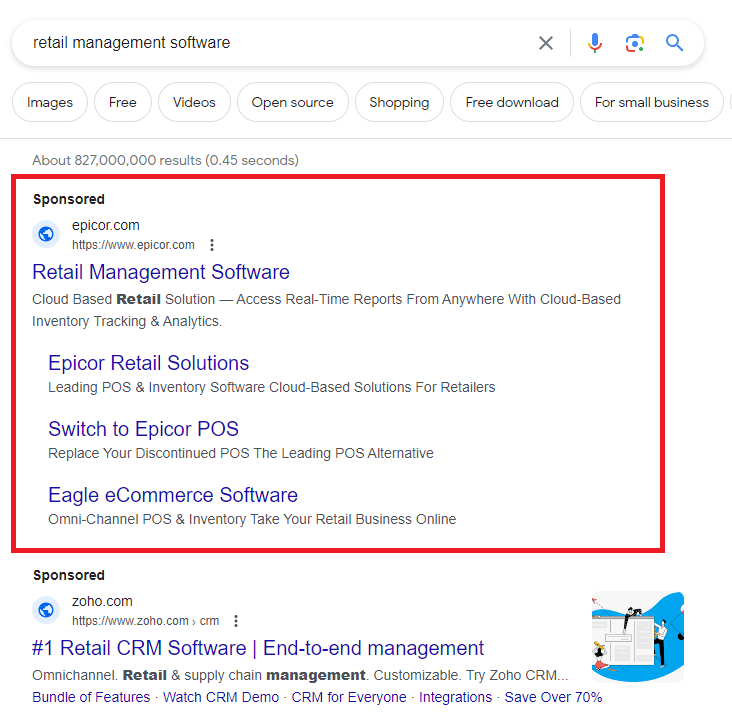
Google Ads is affordable with a high return on ad spend (ROAS), which is how much you spend for a result. You also only pay if someone clicks on your ad in the sponsored results section. You don’t pay anything if no one interacts with your ad.
The challenge with this type of digital advertising is that most good keywords that people search for are extremely competitive. More competition results in a higher price for the keyword.
Still, this can be a viable strategy to meet users at the exact part of their journey where they’re searching for a solution to their problem.
7. Align your sales and marketing teams
When your marketing and sales teams are working in harmony, you have a higher chance of driving inbound sales leads.
However, we realize this is not easy to achieve. Here are three ways to ensure your sales and marketing teams are on the same page:
✅ Keep communication transparent
Most companies that use B2B inbound sales marketing often forget how important it is for these two teams to communicate.
Ensure your marketing professionals and sales representatives speak regularly, either in person or virtually.
Driving a culture of open communication about challenges, goals, and generating leads can help you grow your client base more effectively.
✅ Share information openly
It’s also important that data is regularly shared between these two teams and that it is easily accessible to everyone. Each team member should know how many leads you’re getting, what’s working, and what isn’t.
✅ Have the same goals
Your teams should be aiming to achieve one singular goal, not two separate ones. For example, if your goal is to acquire more clients, your marketing team should work on producing content that attracts leads while your sales reps should focus on converting them into paying customers.

8. Leverage your existing customers
You can use your existing client base to your advantage in your B2B inbound sales marketing efforts.

Here are two ways you can do this:
💼 Referral marketing
Offer your existing customers something in return for referring new leads to your business, such as a discount code, product upgrades, or free items from your brand.
This can help you build a wider network of prospects that can drive online lead generation.
You can also collaborate with B2B blogs to contribute guest posts for your brand. This can help build your credibility and attract qualified leads.
💼 Share positive customer testimonials
You can approach your existing clients to write testimonials about how happy they are with your product or service. You can use these reviews as part of your marketing strategy by posting them on social media platforms and publishing them on your website.
Also known as social proof, this helps establish credibility and trust with prospects who are seeing your content.
9. Implement chatbots on your website
You’d be missing out if you weren’t using chatbots on your website as a quick and easy contact point. Today’s leading solutions go far beyond basic automation—AI customer support agents can now provide dynamic, human-like responses that enhance the customer experience. Choosing an intuitive customer service platform ensures these interactions feel seamless and efficient for both users and support teams.
These AI-driven agents engage with visitors in real time by quickly answering questions, collecting essential data, and helping them move along the sales funnel. Unlike traditional chatbots, AI customer support agents can understand context, personalize interactions, and even learn from past conversations to improve future responses.
Investing in a multichannel messaging platform such as Crisp allows your services to be accessible at any time of the day without requiring a large workforce to answer queries.
You can also automate these chatbots and AI agents to slot seamlessly into your inbound lead generation process, guiding visitors and directing qualified leads to the appropriate department once they’re ready to close the deal.
Take a look at what HubSpot’s chatbot looks like on their website.
The bot provides helpful information and links to several relevant departments that the client might be interested in to help generate inbound leads:
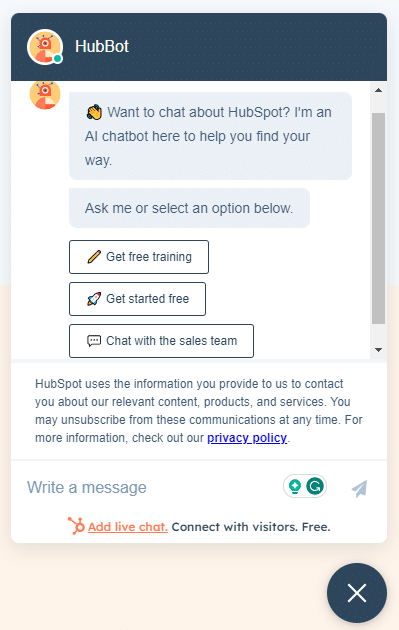
Get the Perfect Tool for Your B2B Inbound Lead Generation Strategies
In the B2B world, competition is fierce. Figuring out how to set your brand apart from your competitors and acquiring new customers is challenging.
However, with a good strategy and aligned teams, you can help your B2B inbound marketing strategies succeed.
One of the most effective ways to stand out from the crowd and attract new clients is to use personalization to your advantage.
In just a few steps, with Hyperise you can set up a website that not only speaks to each lead on a more personal level but also instantly grabs their attention.
You can create personalized text, videos, images, GIFs, and so much more by using the Hyperise editor. Visit our website to start your free trial and see just how effective personalization is for attracting new clients.
Last Updated on November 12, 2025